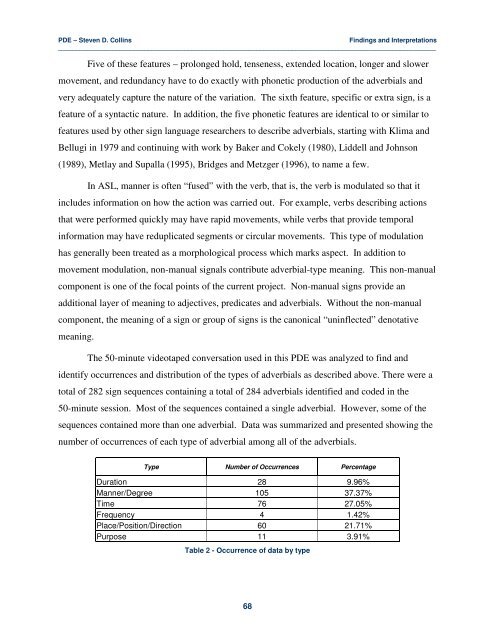Adverbial Morphemes in Tactile ASL - Gallaudet University
Adverbial Morphemes in Tactile ASL - Gallaudet University
Adverbial Morphemes in Tactile ASL - Gallaudet University
You also want an ePaper? Increase the reach of your titles
YUMPU automatically turns print PDFs into web optimized ePapers that Google loves.
PDE – Steven D. Coll<strong>in</strong>s<br />
F<strong>in</strong>d<strong>in</strong>gs and Interpretations<br />
_________________________________________________________________________________________________________<br />
Five of these features – prolonged hold, tenseness, extended location, longer and slower<br />
movement, and redundancy have to do exactly with phonetic production of the adverbials and<br />
very adequately capture the nature of the variation. The sixth feature, specific or extra sign, is a<br />
feature of a syntactic nature. In addition, the five phonetic features are identical to or similar to<br />
features used by other sign language researchers to describe adverbials, start<strong>in</strong>g with Klima and<br />
Bellugi <strong>in</strong> 1979 and cont<strong>in</strong>u<strong>in</strong>g with work by Baker and Cokely (1980), Liddell and Johnson<br />
(1989), Metlay and Supalla (1995), Bridges and Metzger (1996), to name a few.<br />
In <strong>ASL</strong>, manner is often “fused” with the verb, that is, the verb is modulated so that it<br />
<strong>in</strong>cludes <strong>in</strong>formation on how the action was carried out. For example, verbs describ<strong>in</strong>g actions<br />
that were performed quickly may have rapid movements, while verbs that provide temporal<br />
<strong>in</strong>formation may have reduplicated segments or circular movements. This type of modulation<br />
has generally been treated as a morphological process which marks aspect. In addition to<br />
movement modulation, non-manual signals contribute adverbial-type mean<strong>in</strong>g. This non-manual<br />
component is one of the focal po<strong>in</strong>ts of the current project. Non-manual signs provide an<br />
additional layer of mean<strong>in</strong>g to adjectives, predicates and adverbials. Without the non-manual<br />
component, the mean<strong>in</strong>g of a sign or group of signs is the canonical “un<strong>in</strong>flected” denotative<br />
mean<strong>in</strong>g.<br />
The 50-m<strong>in</strong>ute videotaped conversation used <strong>in</strong> this PDE was analyzed to f<strong>in</strong>d and<br />
identify occurrences and distribution of the types of adverbials as described above. There were a<br />
total of 282 sign sequences conta<strong>in</strong><strong>in</strong>g a total of 284 adverbials identified and coded <strong>in</strong> the<br />
50-m<strong>in</strong>ute session. Most of the sequences conta<strong>in</strong>ed a s<strong>in</strong>gle adverbial. However, some of the<br />
sequences conta<strong>in</strong>ed more than one adverbial. Data was summarized and presented show<strong>in</strong>g the<br />
number of occurrences of each type of adverbial among all of the adverbials.<br />
Type Number of Occurrences Percentage<br />
Duration 28 9.96%<br />
Manner/Degree 105 37.37%<br />
Time 76 27.05%<br />
Frequency 4 1.42%<br />
Place/Position/Direction 60 21.71%<br />
Purpose 11 3.91%<br />
Table 2 - Occurrence of data by type<br />
68
















